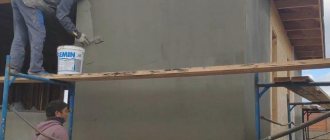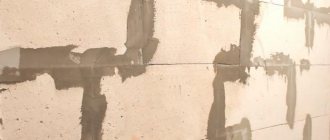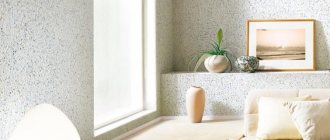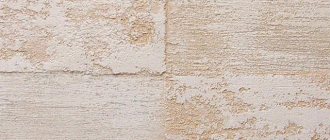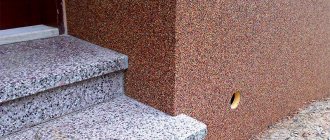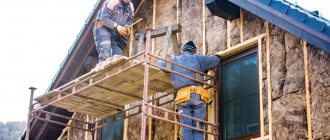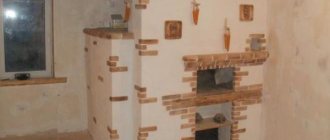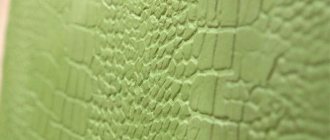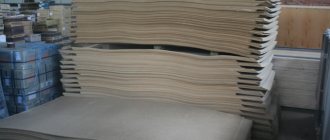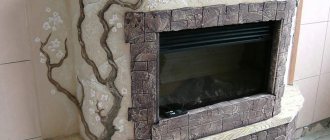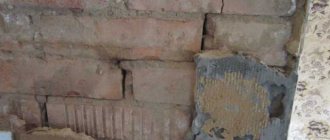Houses made of foam concrete without finishing have an unpresentable appearance. But it is much more important that foam blocks absorb moisture well. Therefore, it is impossible to do without facade work. One of the common solutions is plaster. But keep in mind that the technology for plastering foam blocks on the outside differs from similar work on brick and other stone materials. If you miss a number of points, you won’t be able to get a durable and beautiful façade coating. There are certain nuances already at the stage of choosing materials; you should familiarize yourself with the main ones.
Why does a foam block need plaster?
The walls of a foam block house, with the correct thickness, do not need additional insulation, and the material itself is not afraid of moisture due to its closed pore structure. However, plastering the foam block outside and inside is a standard technique, and it has a positive effect on the following properties:
- Improves thermal insulation: closes cold bridges, protecting housing from weather changes.
- Improves sound insulation.
- Decorative. There is no ideal foam concrete masonry. The plaster solution will help hide surface defects and make it smooth and aesthetically attractive.
If you refuse plastering, the quality of the masonry will begin to decline, since the seams will be unprotected and will begin to collapse over time. This will reduce the life of the house.
Using plaster in the interior Source dizain.guru
Technology of applying plaster to foam concrete
Finishing foam blocks with plaster has several nuances:
- It is better to apply plaster on a pre-treated surface. To do this, the surface of the foam concrete wall can be sanded (cleaned, treated with a grater). Thus, the top layer of the foam block is removed, the pores are opened, and a better indicator of surface adhesion to the plaster mixture is achieved;
- Plaster can be applied to the wall on both sides at the same time (unlike aerated concrete). The fact is that foam concrete does not absorb moisture, which means that when the plaster dries, it completely releases moisture to the outside;
Note. Plaster on foam concrete takes longer to dry, despite the thinner layer of application. But it becomes possible to more accurately level the lined surface and make the plaster smoother.
- Plaster is applied to the wall by spraying. Those. a layer of mortar is sprayed onto the wall (rather than applied to a spatula), and then leveled with a spatula. Next, a final thin layer is applied. It is this that is rubbed until the surface is smooth.
Note. When using a sand-cement mixture, apply a liquid solution to the wall (it will replace the primer layer) and, after complete drying, apply the base layer. The layer can be applied with a brush or spray bottle.
- Painting a foam concrete wall is also done using special “breathable” paints based on silicone or silicate.
Ways to increase adhesion
Foam concrete blocks have a smooth surface that is easy to level. This is an important advantage of the material, allowing you to save effort, time and reduce the consumption of plaster composition. However, here lies the main pitfall: smooth blocks have low adhesion (cohesion), and not every mixture will adhere securely to such a wall.
It is recommended to make plaster for foam blocks up to 10 mm thick on the facade, and up to 20 mm on internal surfaces. Under such conditions, adhesion is increased in two ways:
- An intermediate composition is applied to the foam concrete . A primer, such as contact concrete with additives, is suitable. After application, the primer is left for a period of 10 to 24 hours. During this time, the composition penetrates into the structure of the foam concrete, and on the surface it forms a rough layer sufficient for adhesion.
- Use masonry mesh . To obtain a reinforcing effect, a metal, plastic or polymer mesh is suitable. You cannot do without it if the facing layer is thicker than recommended. The mesh is stuffed onto foam concrete using nails or dowels.
The process of applying plaster Source yandex.net
What is a foam block
This is a cellular building material produced using special technology. It is made from the following components:
- Cement grade M400 and higher is used as a binder;
- as a filler, sand;
- the third component is a foam concentrate on various bases (pine rosin, protein, bone glue);
- water.
Foam concrete is produced using two technologies. In the first case, foam is pre-beaten in a foam generator, which is fed into the cement mortar. The mixture is stirred to distribute air bubbles evenly throughout the entire volume. In the second, the foam is whipped in a special mixer. Then cement and sand are added to it.
Next, the foam concrete blocks themselves are formed from the resulting mass. To do this, the mass is poured into molds, in which, after hardening, ready-made blocks (cast foam concrete) are obtained. The second technology involves filling a single container. After curing, the resulting monolith is cut into standard blocks (sawn foam concrete).
Blocks obtained by casting and sawing have a number of differences. The former may have chips (you appear in a recess from the mold) and an uneven surface on which contamination from lubricants remains (from the walls of the mold). They are characterized by low adhesion. The latter, despite the rough surface, have precisely maintained geometric shapes and good adhesion.
Rice. 1. Molded foam concrete
Attention: dew point
No matter how thick the foam block is, it will cool in winter; additional cold will begin to penetrate through the masonry joints. The plaster layer reduces cooling, but at the same time retains heat in the room. A temperature difference is formed under the inner plaster layer.
If the plaster of the walls made of foam blocks inside the house is made in too thick a layer, then a dew point is formed under it - an area where the cold environment comes into contact with the warm one. Temperature differences will cause condensation. In the future, the accumulation of moisture will lead to the appearance of mold and peeling of the decorative layer.
The only way to combat an undesirable phenomenon is to prevent the conditions for its occurrence. To ensure that moisture leaves the house without lingering and that thermal conductivity is uniform, it is important to maintain the correct proportions of layers. The outer plaster for foam blocks should be twice as thin as the inner layer (5-10 and 10-20 mm, respectively). Maintaining the proportions will shift the dew point outward and keep the interior lining intact.
Applying the first layer Source mr-build.ru
See also: Catalog of companies that specialize in finishing materials and related work
Is it necessary to plaster walls made of foam blocks?
Plastering the foam block is necessary. Such structures, due to their cellular structure and the presence of air pores, are distinguished by high thermal insulation characteristics and the ability to transmit moisture from the room, which ensures the formation of an optimal microclimate in the house.
For the same reason, this material actively absorbs moisture, which sharply reduces its performance parameters:
- heat-saving capabilities are significantly reduced;
- the integrity of the block may be compromised;
- dark spots appear on its surface outside.
The simplest and most effective way to protect the surface of a block is plastering. Applying a layer of plaster inside the house eliminates the occurrence of pockets of pathogenic microflora that can disrupt the optimal microclimate in the premises and cause the destruction of cellular concrete.
Special plastering compositions make it possible to optimize humidity and extend the service life of this material, and counteract the processes of shrinkage of the structure.
How to choose the right mixture
The basic rule is: when choosing plaster for foam blocks, pay attention to the level of adhesion of the plaster mixture. The higher the indicator, the better the cladding will hold.
It is also necessary to take into account the place of use of the composition: for facade or interior decoration. This will help maintain proper air exchange and keep the dew point on the outside of the structure. The following materials are suitable for finishing a foam block facade:
- Acrylic plaster . A popular option based on acrylic polymer (synthetic resins) will insulate the facade and make it decorative. The material is plastic, forms a strong layer, is varied in palette and can be applied using different techniques. Disadvantages: limited service life (compared to silicone mixtures) and low durability of the coloring pigment.
- Silicone . This coating will last 20-25 years, while maintaining its plasticity and self-cleaning property. Silicone has vapor permeability, high adhesion, and will not peel off even in harsh climates. The silicone composition can be applied in a thin layer, and this somewhat compensates for its main disadvantage - its high cost.
Mixing the solution with a mixer Source kraski-net.ru
- Mineral . The mixture consists of cement and various mineral additives; The plaster sets quickly, so it must be applied quickly. The cladding is durable, breathable, with a good level of thermal insulation. If the contractor is not sufficiently qualified, the finishing may turn out to be uneven, which will spoil the appearance of the facade.
- Silicate . The plaster has good adhesion; To obtain a strong adhesion, the wall is treated with a silicate primer. The solution hardens quickly and if you work slowly, the finish will be uneven. The peculiarity of the silicate composition is that it changes color when wet, but then recovers.
The plaster of the foam block from the inside is not subject to the same operating loads as on the facade. However, it must be elastic and moisture-resistant, allow steam to pass through and have increased adhesion. Gypsum and solutions based on it have these qualities. A common composition of gypsum, slaked lime and perlite (rock). The addition of perlite improves the thermal insulation properties of the finish.
Stages of applying plaster Source guruotdelki.ru
Selecting consumables
For preparatory work and for plastering the outside of a house made of foam blocks, we will need the following materials:
- concrete contact or deep penetration primer to strengthen the outer layer and improve adhesion;
- plaster mesh made of fiberglass (galvanized steel can be used, but this option will be more expensive);
- standard beacons that allow you to obtain a flat surface;
- plaster mixtures for external use, intended for foam and aerated concrete, and other cellular blocks.
Good results are obtained by using mixtures of Ceresit, Belsilk, Caverplix. Others with increased adhesion and frost resistance are also suitable.
In order to save money, homemade plaster for foam blocks (external) is also used. It is based on a mixture of cement, sand and lime. Keep in mind that such a solution is incomparable in its performance to professional formulations that contain polymer components.
Working with lime plaster is more difficult, so if you have no experience, it is better to abandon this option in favor of factory-made materials.
Preparation: tools and materials
For plastering work on foam blocks you will need the following set of tools:
- A construction mixer or drill with a mixing attachment for mixing plaster to the desired consistency, as well as a container for mixing.
- Roller with replaceable attachment, narrow and wide brush. With their help you will cover the blocks with primer.
- Convenient size spatula.
- Chisel, saw on concrete.
- Plumb line, rule (possible with a level).
You will also need materials:
- Dry plaster mixture: approximately 1.1 kg per square meter with a thickness of 10 mm. One coat of primer will take approximately 150 g per square area.
- Reinforcing mesh (fine mesh, wire diameter 1-2 mm), nails or screws, as well as a hammer or drill.
- For external work you need scaffolding, for internal work - a stepladder.
There are never too many tools Source 0201.nccdn.net
Reinforcement of plaster with mesh
You can increase the adhesion of foam concrete by gluing (installing) a fine-mesh metal mesh onto the wall (with a wire diameter of 1 mm, the price will be 180 rubles/8 sq.m., with a diameter of 2 mm - 400 rubles/7 sq.m.) or polymer mesh (facade fiberglass mesh 165 g/m2, mesh 4x4 - 5x5 mm, approximate cost - 700-800 rubles/50 sq.m.).
- when choosing a reinforcing mesh, pay attention to its resistance to an alkaline environment, otherwise over time the mesh under the plaster will become unusable and the finishing layer will begin to peel off;
- the mesh can be attached to the wall using dowels or embedded in the first layer of plaster.
Stages of work
Before you start covering the walls with the selected composition, you need to prepare the surface. They operate according to the following algorithm:
- Clean the masonry from dirt to make it easier for the plaster layer to adhere. It is most convenient to use a brush with metal bristles. A drill with a braided wire wheel brush attached will make the job much faster.
- A primer for foam blocks is applied to the cleaned surface in two or three steps. After applying each layer, allow it to dry; the required time is indicated on the packaging.
- If a sand-cement mixture is used for cladding, the primer layer can be replaced with a liquid solution.
The plaster composition is prepared as follows:
- The mixture purchased in the store is diluted in a container with water to the proportion specified in the instructions. Then, using a mixer, the contents of the container are brought to a homogeneous state (stirring takes 5-7 minutes). After a minute, the procedure is repeated.
The primer is convenient to apply with a wide brush Source zhkpribrezhny.rf
Plastering walls outside
General rules
When performing work, you must adhere to the following general rules:
- plastering can be carried out no earlier than 28 days from the date of production of the blocks - compliance with this period is necessary in order to prevent subsequent deformations of the coating;
- the air temperature outside should be no lower than 5º C and no higher than 30º C;
- Before applying the composition, the surface must be carefully prepared - it should be cleaned of dust, dirt and greasy stains. After that it is primed. Thanks to this, self-applied plaster of foam blocks will adhere more firmly to the surface of the walls;
In the photo - applying primer
- in the case of applying the plaster composition in several layers, this must be done gradually - each subsequent layer can be applied only after the previous one has dried. The dried first layer is primed, after which another layer is applied on top of it, which should be thinner than the previous one.
Recommendations for carrying out work
Before you start work, you need to check the wall for deviations from the vertical. This can be done using a special tool - a building level.
Let's say you have established that the existing irregularities do not exceed 5 mm. How to plaster foam block walls in this case?
Two layers will be enough here. First, putty is applied for preliminary leveling. Then the surface is sanded and a second layer of putty is applied. It's called finishing.
Before applying each layer, priming is carried out. For this purpose, an impregnating primer is used, intended for materials that easily absorb moisture.
To prevent cracks from appearing at the joints of the blocks, we recommend that you use a painting mesh. It will need to be “smeared” into the first layer.
Applying a grid
- Interior decoration of a house made of foam blocks
Now consider the option when the vertical deviation is more than 5 mm. How to properly plaster walls made of foam blocks in this case? In these conditions, you will have to do things a little differently and use beacons.
First of all, we carry out, of course, priming of foam block walls. Apply the solution to the entire surface of the walls being treated.
Having completed this stage of work, we move on to the next one. Now we have to install plaster beacons measuring 6 mm. After this, apply the first layer of the mixture.
We install plaster beacons
It will be necessary to embed a fabric mesh with cells measuring 5x5 centimeters or more in it. However, you cannot attach it directly to the wall. You need to make sure that it is at a distance of 1/3 layer from the wall.
Next, the procedure for plastering foam blocks will be slightly different than in the first case. Now we will not wait for the first layer to harden. We will immediately apply the second layer and align it with the beacons. After half an hour, the beacons will need to be removed and the grooves sealed.
Then the final leveling of the surface is carried out. This improves the adhesion of the plaster layer and the working surface.
We perform final leveling
After this, we need to wait for the plaster to dry completely. And only then do we move on to applying the decorative coating.
It can be silicate or silicone paint. Only it will have the required level of vapor permeability. This coating will allow the walls, as they say, to “breathe.”
Silicate paint for facade
In general, plastering foam concrete from the outside is not such a difficult process. Especially when you have knowledge of how to properly plaster foam blocks.
Briefly about the main thing
Creating a plaster layer on foam concrete walls is a practical way to improve the performance of a structure. In order for the finishing layer to be of high quality, the preparatory work cannot be ignored.
Foam blocks have a particularly smooth surface, so their adhesion is increased artificially: they are treated with a primer, and for additional reinforcement, a fine mesh is used. It is necessary to take into account other subtleties: the dew point will not shift inside the housing if the ratio of the thickness of the internal and external cladding is maintained.
Plaster mixtures of different compositions are suitable for external and internal finishing work. If you do not want to use a ready-made mixture, you can prepare it using a home recipe.
Ratings 0
Possible errors and useful tips
So:
- Trying to do all the work yourself. This is a common mistake; it is worth involving at least one assistant. Firstly, the work will be carried out much faster, and secondly, with better quality. For example, one person can apply the mixture while another person kneads it.
- The work should be carried out in the off-season; the best time is spring. This is due to the requirement to maintain a temperature from 5 to 30 degrees.
- It is imperative to purchase only galvanized mesh, since the mesh, not being protected from the effects of alkali, can become unusable and cause irreparable damage to the coating.
- The intervals between application of layers should be observed especially strictly. The results of haste can be cracks in the coating and similar negative consequences.
- Another common mistake is attaching fiberglass mesh directly to the foam blocks. This should not be done, since in this case, the mesh will not be able to perform its useful function, and its installation will be pointless.
Many amateurs and beginners decide to finish the facade first, which is incorrect. External plastering of foam concrete should be carried out after work has been carried out inside the building, which is dictated by the characteristics of the material.
Why do you need to plaster foam concrete blocks?
Plastering walls made of foam blocks, as well as plastering walls made of gas silicate blocks and other porous materials, allows you to solve many problems:
- protect walls made of foam concrete blocks from temperature changes, moisture condensation and the formation of dampness;
- provide improved aesthetic perception of the building walls;
- increase the thermal insulation characteristics and improve the sound insulation of a foam concrete house;
- eliminate height differences after masonry and ensure the flatness of the wall surface;
- increase the service life of a foam concrete structure by preventing cracking of walls;
- maintain a comfortable microclimate inside the building due to improved thermal insulation.
Foam concrete needs additional protection due to its porous structure.
Plastering the surface of foam concrete blocks on the inside and façade of a building increases the service life of the building, does not impede free air exchange, and also creates favorable conditions for living.
Features of external and internal plaster
There are several options for plastering walls; let’s look at each of them in more detail:
- Some craftsmen are in a hurry to cover the foam blocks with plaster on the outside of the building. In this case, all the steam will be directed inside the house, which increases the process of drying the walls, and finishing the interior of the building is delayed. If the house is located on the shore of a reservoir, then first of all the walls are finished on the outside.
- When finishing indoors, steam will freely pass through the foam blocks and evaporate. After the plaster and walls of the house have dried, you can begin to carry out the exterior finishing. This is the most correct option.
- When finishing the walls on both sides at the same time, moisture remains inside, as it does not have time to evaporate, which in winter can cause peeling of the plaster, so this is the worst option.
